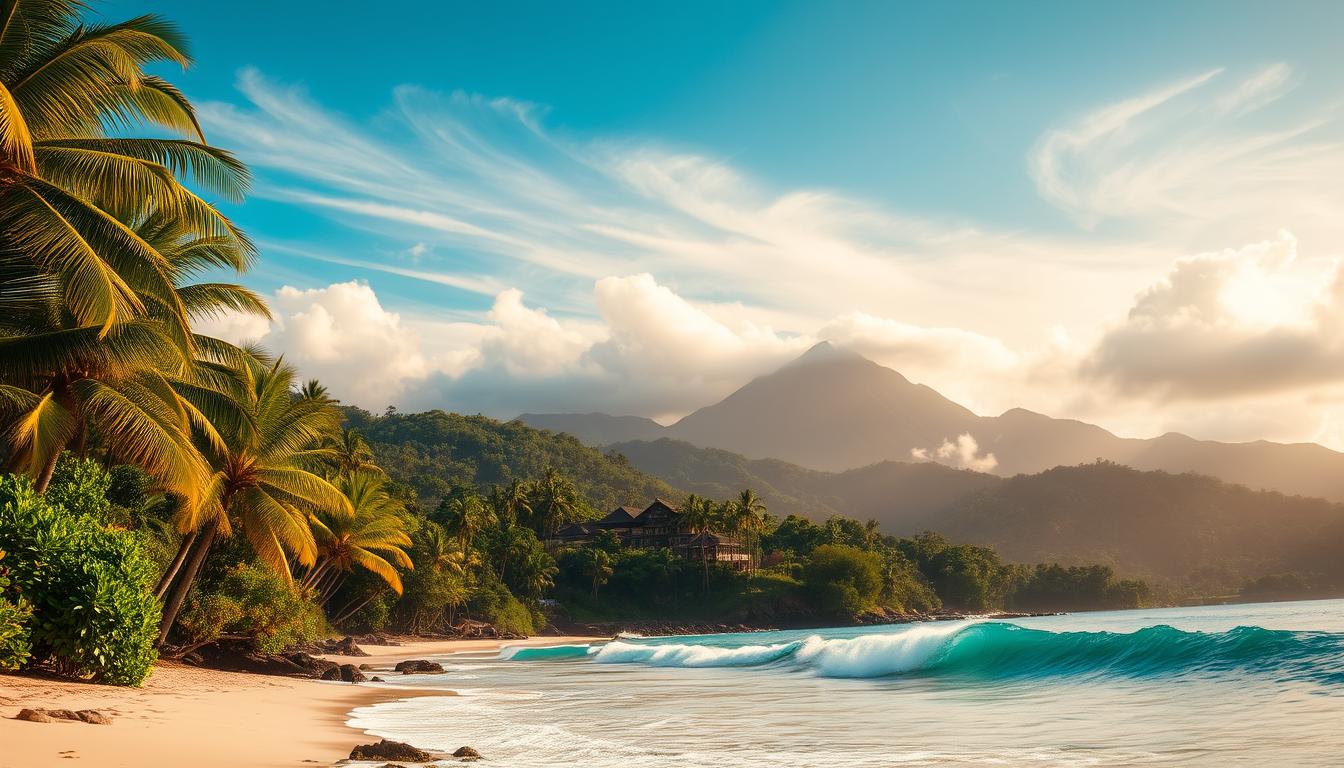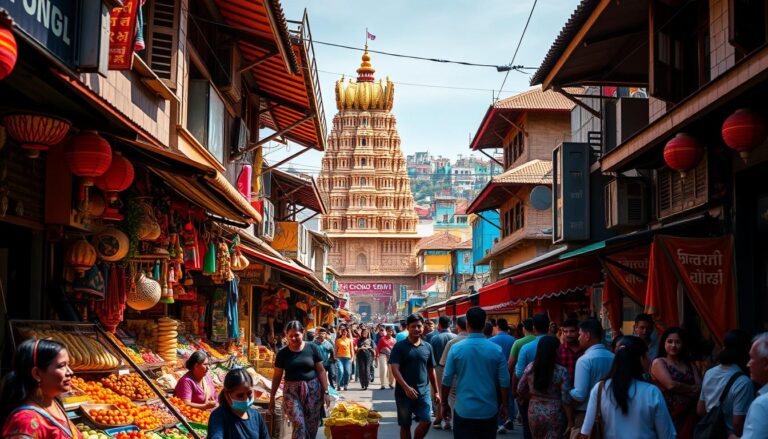
Bali is more than just an island—it’s a dream destination that captivates travelers with its stunning landscapes and vibrant culture. From pristine beaches to lush rice terraces, this tropical paradise offers a perfect blend of relaxation and adventure. Whether you’re planning a romantic getaway or an action-packed trip, Bali promises an unforgettable experience.
The island is renowned for its unique mix of modern amenities and ancient traditions. Temples like Pura Tanah Lot and Uluwatu stand as testaments to its rich heritage, while beach clubs and luxury resorts cater to contemporary tastes. Every corner of Bali tells a story, inviting you to explore its hidden gems and iconic landmarks.
This guide is designed to help you make the most of your journey. Whether you’re a budget traveler or seeking luxury, you’ll find practical tips and insider advice to enhance your visit. Let’s dive into the wonders of Bali and uncover what makes it a truly magical destination.
Key Takeaways
- Bali is a tropical paradise with stunning beaches and cultural landmarks.
- The island offers a mix of modern amenities and ancient traditions.
- Explore hidden gems and iconic sites for a well-rounded trip.
- Practical tips and insider advice cater to all types of travelers.
- Bali’s unique charm makes it a dream destination for relaxation and adventure.
Discovering Bali’s Enchanting Landscape
From towering mountains to serene beaches, Bali’s geography is as diverse as its culture. This island paradise offers a unique blend of natural wonders and vibrant traditions, making it a top destination for travelers seeking both adventure and relaxation.
Overview of Bali’s Geography and Cultural Diversity
Bali’s landscape is a stunning mix of mountains, lakes, and coastal regions. The central highlands, home to Mount Batur and Lake Bratan, provide a cool retreat from the tropical heat. Coastal areas like Seminyak and Uluwatu are famous for their golden sands and world-class surf spots.
The island’s cultural diversity is equally captivating. Ancient temples, such as Pura Besakih, stand alongside modern beach clubs, showcasing Bali’s ability to blend tradition with contemporary life. Festivals like Nyepi and Galungan highlight the island’s spiritual heritage, offering visitors a glimpse into its rich traditions.
The Historical Roots That Shape Modern Bali
Bali’s history has deeply influenced its present-day culture. The island’s subak irrigation system, recognized by UNESCO, reflects the community’s respect for nature and sustainable practices. This ancient system still supports the lush rice terraces that define Bali’s countryside.
Historical events, such as the arrival of Hinduism, have shaped Bali’s spiritual landscape. Temples like Pura Tanah Lot and Uluwatu are not just tourist attractions but also active places of worship. These sites offer a window into the island’s past while remaining integral to its modern identity.
Understanding Bali’s natural and cultural landscape enriches the travel experience. Whether exploring highland retreats or vibrant beach towns, visitors gain a deeper appreciation for this enchanting island.
Top Must See in Bali Attractions
Bali’s allure lies in its blend of natural beauty and cultural richness. The island is home to iconic landmarks that tell stories of its history and traditions. From ancient temples to breathtaking landscapes, these attractions are a central part of the Bali experience.
Highlights from Iconic Landmarks
One of the most famous temples is Tanah Lot, perched on a rocky outcrop overlooking the ocean. Open from 7:00 AM to 7:00 PM, it’s best visited early to avoid crowds. Another must-visit place is Ubud Monkey Forest, where over 700 Balinese long-tailed monkeys roam freely. This sanctuary is open daily from 8:30 AM to 6:00 PM.
![]()
For those seeking adventure, Mount Batur offers an unforgettable sunrise trek. Guided treks typically start around 3:30 AM, taking 4-5 hours to complete. The journey rewards hikers with panoramic views of the island’s volcanic landscape.
Cultural enthusiasts will appreciate Pura Besakih, the largest temple complex on the island. Known as the “Mother Temple of Bali,” it’s a sacred site steeped in history. Similarly, Tirta Empul, located 30 kilometers northeast of Ubud, is renowned for its holy spring water.
Tips for Visiting Bali’s Landmarks
To make the most of your visit, consider these tips:
- Arrive early to avoid crowds and enjoy a peaceful experience.
- Hire a local guide for deeper insights into the history and significance of each site.
- Join a tour to explore multiple attractions in one day.
- Respect local customs, especially when visiting temples.
| Attraction | Best Time to Visit | Duration |
|---|---|---|
| Tanah Lot Temple | 7:00 AM – 9:00 AM | 2-3 hours |
| Ubud Monkey Forest | 8:30 AM – 10:30 AM | 1-2 hours |
| Mount Batur Trek | 3:30 AM – 8:00 AM | 4-5 hours |
| Pura Besakih | 9:00 AM – 12:00 PM | 2-3 hours |
Each landmark in Bali is a place of wonder, offering a glimpse into the island’s soul. Whether you’re exploring ancient temples or hiking volcanic peaks, these attractions promise an unforgettable journey.
Exploring Bali’s Pristine Beaches and Coastal Vibes
Bali’s coastline is a treasure trove of sun-soaked beaches and vibrant coastal energy. From the lively shores of Seminyak to the serene landscapes of Nusa Penida, the island offers something for every traveler. Whether you’re looking to relax, surf, or explore, Bali’s beaches are a perfect escape.
Relaxing at Seminyak, Kuta, and Uluwatu Beaches
Seminyak is known for its soft sands and upscale beach clubs. It’s a hotspot for those seeking a blend of relaxation and luxury. The clear blue water and vibrant atmosphere make it a favorite among visitors.
Kuta, on the other hand, is famous for its beginner-friendly waves. It’s a great spot for new surfers and those who enjoy a lively beach scene. The area is also home to affordable accommodations and bustling nightlife.
Uluwatu stands out for its dramatic cliffs and world-class surf breaks. The beaches here are perfect for capturing stunning sunsets. The cliffside amphitheater adds a cultural touch, hosting traditional Kecak dance performances.
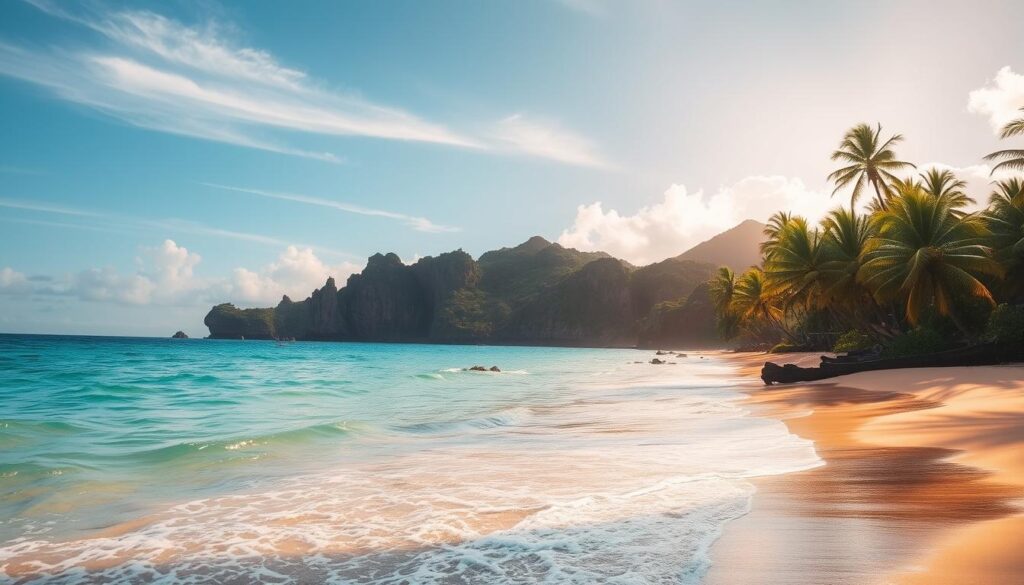
Nusa Penida Island Getaways
Just a short boat ride from Bali, Nusa Penida offers breathtaking landscapes and a peaceful retreat. The island is known for its crystal-clear water and dramatic cliffs, making it a paradise for nature lovers.
Popular spots include Kelingking Beach, often called the “T-Rex Beach” due to its unique shape, and Angel’s Billabong, a natural infinity pool. These locations are perfect for photography and exploration.
When visiting Nusa Penida, plan ahead to avoid crowds. Early mornings are ideal for enjoying the serene beauty of this hidden gem.
| Beach | Highlights | Best Time to Visit |
|---|---|---|
| Seminyak | Upscale beach clubs, soft sands | Late afternoon |
| Kuta | Beginner-friendly waves, vibrant nightlife | Morning for surfing |
| Uluwatu | Cliffside views, surf breaks | Sunset |
| Nusa Penida | Dramatic cliffs, crystal-clear water | Early morning |
Bali’s beaches are more than just destinations—they’re experiences. Whether you’re lounging in Seminyak, surfing in Kuta, or exploring Nusa Penida, each beach offers a unique adventure. Plan your visit wisely to make the most of these coastal wonders.
Cultural Wonders: Temples and Spiritual Sites
Bali’s spiritual essence shines through its ancient temples and sacred sites, offering visitors a deep connection to its cultural heritage. These places are not just architectural marvels but also active centers of worship, reflecting the island’s devotion to Balinese Hinduism. Each temple tells a story of faith, history, and natural beauty, making them must-visit destinations for anyone seeking a meaningful experience.
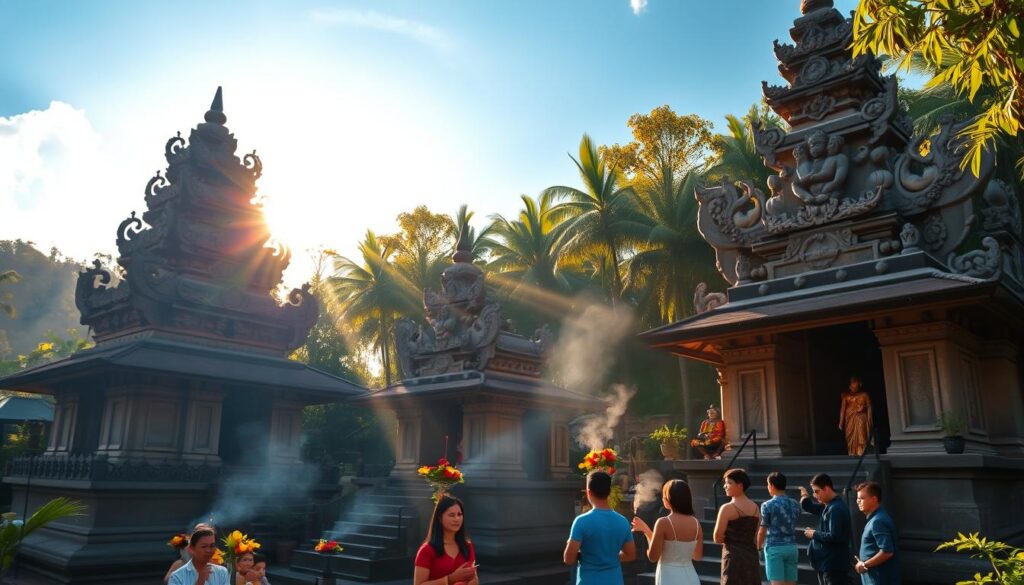
Ulun Danu Beratan and Pura Lempuyang Experiences
Perched on the shores of Lake Beratan, Ulun Danu Beratan is a serene temple dedicated to Dewi Danu, the goddess of water. Its lakeside setting creates a tranquil atmosphere, perfect for reflection and photography. The temple complex, established in 1556, features four sacred buildings that blend harmoniously with the surrounding landscape.
For those seeking a mystical adventure, Pura Lempuyang offers the famed “Gate of Heaven.” Located 1,700 steps above sea level, this temple provides breathtaking views of Mount Agung. The climb is steep but rewarding, offering a spiritual journey as much as a physical one.
Besakih and Tirta Empul: Sacred Encounters
Known as the “Mother Temple,” Besakih is the largest and most important temple in Bali. It’s a sprawling complex with multiple shrines, often bustling with worshippers during major ceremonies. Its location on the slopes of Mount Agung adds to its spiritual significance.
Tirta Empul, on the other hand, is renowned for its holy spring water. Visitors can participate in the melukat purification ritual, which involves bathing under the temple’s 30 waterspouts. This experience is both cleansing and enlightening, offering a unique connection to Balinese spirituality.
Visitor Tips for Spiritual Sites
When visiting these sacred places, it’s essential to dress modestly. Most temples provide sarongs and sashes at the entrance. Arriving early helps avoid crowds and ensures a peaceful experience. Hiring a local guide can also enrich your visit with deeper insights into the history and rituals of each site.
| Temple | Highlights | Best Time to Visit |
|---|---|---|
| Ulun Danu Beratan | Lakeside setting, photography | Morning |
| Pura Lempuyang | “Gate of Heaven,” Mount Agung views | Early morning |
| Besakih | Mother Temple, spiritual ceremonies | Mid-morning |
| Tirta Empul | Purification rituals, holy spring water | Late morning |
Bali’s temples are more than just landmarks—they’re gateways to understanding the island’s soul. Whether you’re drawn to the tranquility of Ulun Danu Beratan or the mystical allure of Pura Lempuyang, these sacred sites promise an unforgettable journey into Bali’s spiritual heart.
Immersing in Bali’s Natural Beauty: Waterfalls and Rice Terraces
Bali’s natural beauty is a harmonious blend of cascading waterfalls and lush rice terraces. These landscapes not only captivate the eye but also tell stories of the island’s agricultural heritage and cultural traditions. Whether you’re chasing the misty spray of a waterfall or wandering through emerald-green rice fields, these natural wonders promise an unforgettable experience.
Sekumpul, Banyumala, and Other Waterfall Treasures
Among Bali’s many waterfalls, Sekumpul stands out as one of the most breathtaking. With six to seven cascades dropping from a height of 80 meters, it’s a sight to behold. The surrounding jungle adds to its dramatic beauty, making it a favorite for photographers and nature lovers alike.
Banyumala, also known as the Yellow Waterfall, offers a serene escape. Its twin streams flow into a crystal-clear pool, perfect for a refreshing dip. For those seeking adventure, Aling Aling features four cascades, including a thrilling natural slide.
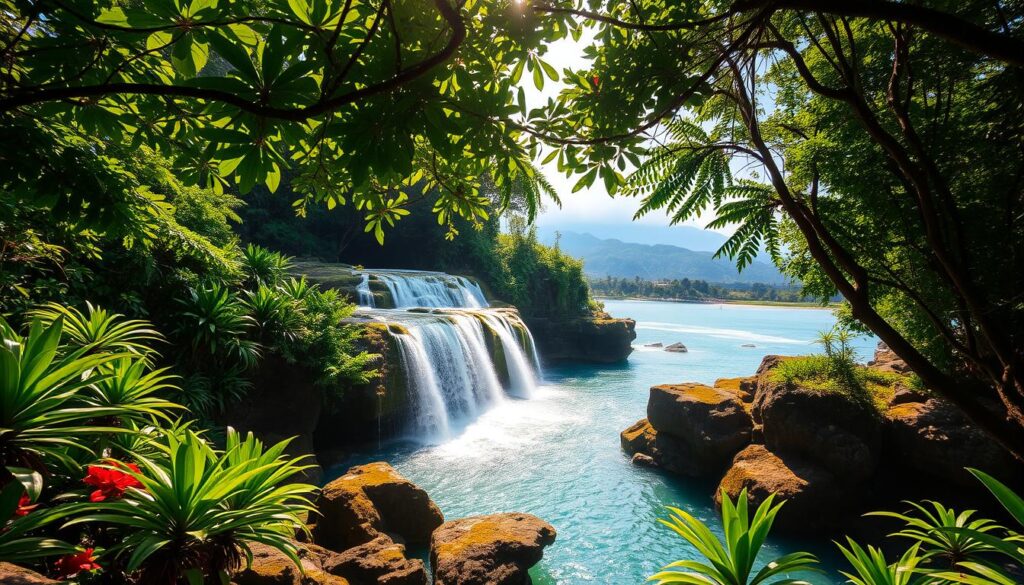
Visiting these waterfalls requires some planning. Arrive early to avoid crowds and enjoy the tranquil atmosphere. Entry fees range from $2 to $10, and hiring a local guide can enhance your experience with insights into the area’s history and ecology.
Exploring Jatiluwih and Tegallalang Rice Terraces
Bali’s rice terraces are a testament to the island’s agricultural ingenuity. Jatiluwih, a UNESCO World Heritage site, spans over 600 hectares and showcases the traditional Subak irrigation system. The rolling green fields are a photographer’s dream, especially during sunrise or sunset.
Tegallalang, located near Ubud, is another iconic destination. Its intricate terrace design creates a mesmerizing pattern across the landscape. Visitors can stroll through the fields, interact with local farmers, and learn about traditional rice cultivation.
When exploring these rice terraces, respect the local culture. Avoid stepping on the fields and consider purchasing handmade crafts from nearby vendors. Entry fees are typically around $1 to $3, making it an affordable yet enriching experience.
Bali’s waterfalls and rice terraces are more than just scenic spots—they’re windows into the island’s soul. Whether you’re marveling at the power of Sekumpul or the artistry of Jatiluwih, these natural wonders add depth and authenticity to your journey.
Adrenaline-Pumping Adventures
For thrill-seekers, Bali offers heart-pounding adventures that go beyond the ordinary. From sliding down natural waterfall chutes to leaping off towering cliffs, the island is a playground for those craving excitement. These activities not only provide an adrenaline rush but also create unforgettable memories.
Thrills of Waterfall Slides and Cliff Jumps
One of the most exhilarating experiences in Bali is sliding down a waterfall. Locations like Sekumpul and Aling Aling feature natural rock slides that send you cascading into refreshing pools below. The rush of the waterfall combined with the lush jungle surroundings makes this a must-try activity.
For those who prefer heights, cliff jumping is another popular adventure. Spots like Nusa Penida and Uluwatu offer dramatic cliffs with crystal-clear waters below. The thrill of free-falling before plunging into the ocean is unmatched.
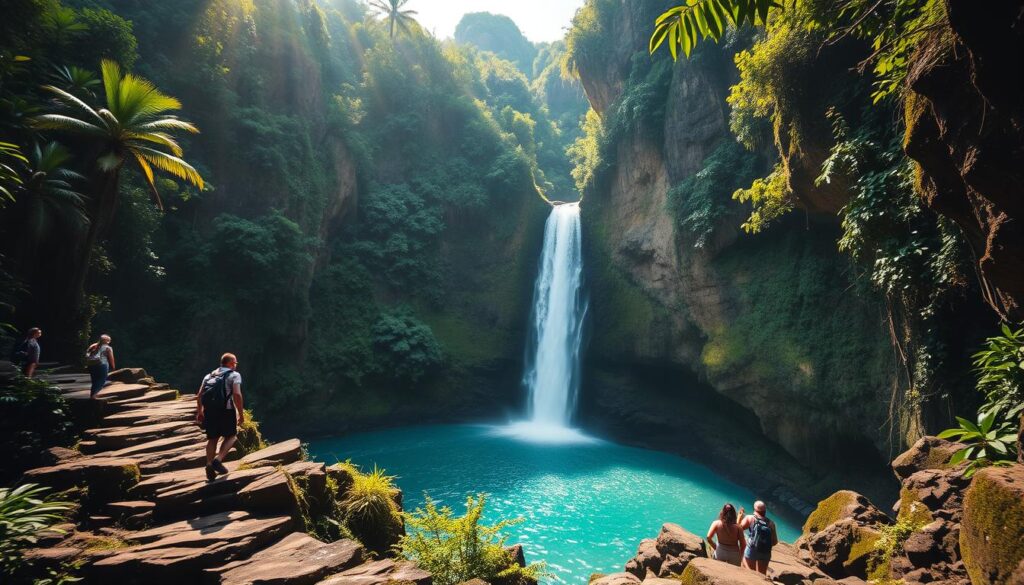
Safety is paramount when engaging in these activities. Always wear a life jacket and proper footwear to prevent injuries. Hiring a local guide ensures you’re aware of the safest spots and current conditions. Their expertise can turn a risky adventure into a thrilling yet secure experience.
Popular Spots for Adventure Seekers
Here are some top locations for waterfall slides and cliff jumps:
| Location | Activity | Safety Tips |
|---|---|---|
| Sekumpul Waterfall | Waterfall sliding | Wear water shoes, hire a guide |
| Aling Aling Waterfall | Natural slides, cliff jumps | Check water depth, avoid rainy season |
| Nusa Penida | Cliff jumping | Use life jackets, avoid risky heights |
| Uluwatu | Cliff diving | Follow local advice, avoid strong currents |
Whether you’re sliding down a waterfall or leaping off a cliff, Bali’s adventurous side promises an unforgettable experience. Plan ahead, stay safe, and let the island’s natural beauty amplify your thrill.
Hidden Gems Beyond the Crowds
Beyond the bustling tourist hubs, Bali hides serene spots that offer a peaceful escape. These lesser-known locations provide a refreshing retreat for those seeking tranquility. Away from the crowds, you’ll find quaint villages, serene landscapes, and off-the-beaten-path treasures that reveal the island’s authentic charm.
One such place is Sidemen Valley, nestled in the foothills of Mount Agung. With its picturesque rice terraces and fields of chilis, coffee, and cacao, it’s a good spot for a quiet getaway. The valley’s single main road ensures it remains untouched by mass tourism, offering a genuine experience of Balinese culture.

For nature lovers, Tukad Cepung Waterfall is a must-visit. Located just a 20-minute walk from Ubud, this hidden gem is rated 10/10 for its untouched beauty. The waterfall’s cascading streams create a magical atmosphere, perfect for photography and relaxation.
Lean village, part of Amed on Bali’s eastern tip, is another place worth exploring. Known for its black-sand bay and traditional fishermen’s homes, it offers a glimpse into local life. The village’s 100 jukung outriggers lining the beach add to its unique charm.
Here are some insider tips for discovering these hidden gems:
- Visit early in the morning to avoid crowds and enjoy the serene atmosphere.
- Hire a local guide to uncover lesser-known spots and learn about their history.
- Respect local customs and traditions, especially in rural areas.
Exploring these hidden locations often delivers a more personal and genuine experience. From secret cafes to small markets, these spots are cherished by locals and offer a deeper connection to Balinese culture.
| Location | Highlights | Best Time to Visit |
|---|---|---|
| Sidemen Valley | Rice terraces, Mount Agung views | Early morning |
| Tukad Cepung Waterfall | Untouched beauty, photography | Mid-morning |
| Lean Village | Black-sand bay, traditional homes | Late afternoon |
Bali’s hidden gems are a lot more than just scenic spots—they’re gateways to the island’s soul. Whether you’re wandering through Sidemen Valley or marveling at Tukad Cepung, these treasures promise an unforgettable journey.
Savoring Bali: Local Food and Dining Delights
Bali’s culinary scene is a vibrant tapestry of flavors, blending tradition with innovation. From bustling street markets to upscale restaurants, the island offers a diverse range of dining experiences. Whether you’re a foodie or a casual traveler, Bali’s cuisine promises to delight your taste buds.
Traditional Balinese Dishes and Authentic Street Eats
One of the most iconic dishes is Babi Guling, a succulent roasted pig often served at ceremonies. Another must-try is Bebek Betutu, a slow-cooked duck dish packed with aromatic spices. These dishes highlight the island’s rich culinary heritage.

Street food is an integral part of Bali’s food culture. From sate lilit (minced meat skewers) to klepon (sweet rice balls), the options are endless. These affordable and flavorful bites are perfect for exploring the island’s authentic flavors.
Renowned Eateries and Must-Try Delicacies
For a memorable dining experience, visit restaurants like Warung Made or Bebek Bengil. These spots are known for their traditional recipes and cozy ambiance. Don’t miss trying lawar, a mix of vegetables, coconut, and meat, often served during special occasions.
If you’re in Ubud, the Ubud Food Festival is a great way to sample local delicacies. Held annually, it showcases the island’s culinary creativity. Cooking classes are also popular, offering hands-on lessons in preparing Balinese dishes.
Cultural Significance of Food
Food plays a central role in Balinese culture, especially during festivals. Dishes like nasi campur (mixed rice) are staples at family gatherings. Rice, in particular, symbolizes prosperity and is a key ingredient in many meals.
Street vendors often prepare food for religious ceremonies, blending culinary traditions with spiritual practices. This connection between food and culture makes dining in Bali a truly enriching experience.
Finding Authentic Dining Experiences
To discover hidden gems, explore local markets like Denpasar Night Market. These spots offer a variety of street food and fresh ingredients. For a more upscale experience, book a table at a beachfront restaurant in Seminyak or Jimbaran.
When dining, respect local customs. Always wash your hands before eating and avoid wasting food. These small gestures show appreciation for the island’s culinary traditions.
Bali’s food culture is a journey of flavors and traditions. Whether you’re savoring street food or dining at a luxury restaurant, every bite tells a story of the island’s vibrant heritage.
Markets and Artisan Workshops: A Taste of Local Culture
Bali’s markets and artisan workshops offer a vibrant glimpse into the island’s rich cultural heritage. These bustling hubs are more than just places to shop—they’re windows into the traditions and creativity of the Balinese people. From handmade crafts to intricate textiles, every item tells a story of skill and artistry.
Discovering the Ubud Traditional Art Market and Crafts
The Ubud Traditional Art Market, known locally as Pasar Seni Ubud, is a must-visit for any visitor. Open daily from early morning to late afternoon, this market is a treasure trove of handmade goods. Here, you’ll find everything from batik fabrics to wood carvings and silver jewelry, all crafted by local artisans.
Exploring the market is an experience in itself. The vibrant atmosphere, filled with the chatter of vendors and the scent of incense, immerses you in Balinese culture. Early mornings are the best time to visit, offering a quieter and more personal shopping experience.
When it comes to shopping, bargaining is part of the fun. Start by offering half the asking price and negotiate politely. Many vendors are happy to share the stories behind their creations, adding depth to your purchase. Remember to carry cash, as most stalls don’t accept credit cards.
Beyond the market, Ubud is home to numerous artisan workshops. These spaces allow visitors to witness traditional crafts being made and even participate in hands-on workshops. Whether it’s weaving, painting, or carving, these experiences connect you to the island’s artistic soul.
Markets and workshops are more than just places to shop—they’re cultural experiences. They offer a deeper understanding of Balinese traditions and the artistry that defines this island. Take your time, engage with the locals, and bring home a piece of Bali’s heritage.
Navigating Bali: Transportation and Travel Tips
Getting around Bali is easier than you might think, with a variety of transportation options to suit every traveler. Whether you prefer the freedom of a motorbike or the convenience of a private driver, the island’s transport network ensures a smooth journey. Here’s a guide to help you navigate Bali like a pro.
Car Charters, Motorbike Rentals, and Taxi Solutions
For those who value comfort, hiring a private driver is a popular choice. A full-day charter typically costs around Rp 600,000 ($40), offering flexibility to explore at your own pace. Pre-booking airport transfers is another smart tip to save time and avoid last-minute hassles.
Motorbikes are a budget-friendly option, with daily rentals ranging from Rp 60,000 to Rp 95,000. However, always ensure you have an International Driver’s Permit (IDP) to avoid fines. Stick to quieter roads if you’re new to riding, and always wear a helmet for safety.
Rideshare apps like GOJEK and Grab are widely used for short trips. Drivers in bright green jackets are easy to spot, and fares are often cheaper than traditional taxis. For longer distances, Bluebird taxis are a reliable choice, especially in Southern Bali and Ubud.
Practical Tips for Smooth Travel
To make the most of your travel, plan your routes during off-peak hours. Traffic is heaviest between 6–8 am and 4–7 pm, so aim to avoid these times. Carry cash, as many smaller businesses and temples don’t accept cards.
Finally, always allow extra time when moving between attractions. Bali’s roads can be busy, and unexpected delays are common. With these tips, you’ll navigate the island with ease and enjoy every moment of your adventure.
Where to Stay: Bali Accommodations and Resorts
Bali’s accommodations cater to every traveler, offering a mix of luxury, comfort, and cultural charm. Whether you’re seeking a lavish resort, a cozy boutique hotel, or a private villa, the island has something to suit your style and budget. From beachfront retreats to jungle hideaways, each option provides a unique experience that enhances your stay.
Luxury Resorts, Boutique Hotels, and Private Villas
For those who crave indulgence, Bali’s luxury resorts are second to none. Properties like Four Seasons Jimbaran Bay and The St. Regis Bali offer world-class amenities, including private pools, spa services, and ocean views. These resorts are perfect for travelers looking to unwind in style.
Boutique hotels, such as The Kayon Jungle Resort in Ubud, provide a more intimate setting. These properties often feature unique designs inspired by Balinese culture, offering a blend of comfort and authenticity. Many boutique hotels also include personalized services, making them a great choice for couples or solo travelers.
Private villas are ideal for groups or couples seeking privacy and exclusivity. Villas like Eco Six Bali and Camaya Bali feature stunning designs, often incorporating natural materials like bamboo. With amenities like infinity pools and private chefs, these villas create a home-away-from-home experience.
Popular Areas for Accommodations
Seminyak is a top choice for luxury stays, with its upscale resorts and vibrant nightlife. Ubud, known for its lush landscapes and cultural hubs, offers a serene retreat for nature lovers. Jimbaran Bay, with its calm waters and family-friendly atmosphere, is another excellent option.
Here’s a quick comparison of these areas:
| Area | Highlights | Best For |
|---|---|---|
| Seminyak | Luxury resorts, beach clubs | Nightlife, shopping |
| Ubud | Boutique hotels, rice terraces | Nature, culture |
| Jimbaran Bay | Family-friendly resorts, calm waters | Relaxation, dining |
Booking Tips and Policies
To secure the best place, book accommodations well in advance, especially during peak seasons. Check cancellation policies, as some properties offer flexible options. Many resorts and villas also provide special packages, including spa treatments or guided tours, so inquire about these when booking.
Whether you choose a luxury resort, a boutique hotel, or a private villa, Bali’s accommodations ensure a memorable stay. Each option reflects the island’s unique charm, making your trip truly unforgettable.
Iconic Landmarks and Photo Opportunities
Bali’s iconic landmarks are more than just beautiful—they’re a photographer’s dream. From the majestic Handara Gate to breathtaking scenic viewpoints, these spots offer a perfect blend of natural beauty and cultural significance. Whether you’re a professional photographer or a casual traveler, these landmarks promise unforgettable experiences and stunning visuals.
Capturing the Beauty of Handara Gate and Scenic Vistas
Handara Gate, with its traditional Balinese architecture and lush mountain backdrop, is one of the most photographed spots on the island. The gate’s symmetrical design and serene surroundings make it a favorite for both travelers and influencers. Early mornings are the best time to visit, as the soft light enhances the gate’s beauty and fewer crowds allow for uninterrupted shots.
Beyond Handara Gate, Bali is home to numerous scenic viewpoints that showcase its diverse landscapes. From rice terraces to volcanic peaks, these spots provide endless opportunities for capturing the island’s essence. Hiring a local guide can help you discover hidden corners and lesser-known locations that are equally photogenic.
Here are some tips for capturing the best photos:
- Visit during golden hours (early morning or late afternoon) for optimal lighting.
- Use a wide-angle lens to capture the grandeur of landmarks like Handara Gate.
- Experiment with different angles to create unique compositions.
- Respect local customs and avoid trespassing on private property.
These landmarks are not just visual treats—they also tell stories of Bali’s rich culture and history. For example, Handara Gate is part of a golf resort but symbolizes the island’s traditional architecture. Understanding these narratives adds depth to your experience and photos.
| Landmark | Best Time to Visit | Photography Tips |
|---|---|---|
| Handara Gate | Early morning | Use wide-angle lens, capture symmetry |
| Rice Terraces | Late afternoon | Focus on layers, include human element |
| Volcanic Peaks | Sunrise | Use tripod, capture misty atmosphere |
Exploring Bali’s iconic landmarks is a journey of discovery and creativity. Whether you’re framing Handara Gate or capturing a scenic vista, these spots offer a glimpse into the island’s soul. Plan your visit, bring your camera, and let Bali’s beauty inspire your next masterpiece.
Sunset Spectacles: Tanah Lot and Uluwatu Views
Witnessing a sunset in Bali is an experience that blends natural beauty with spiritual serenity. Two of the most iconic spots for this magical moment are Tanah Lot and Uluwatu. These locations offer more than just stunning views—they provide a glimpse into the island’s mystical charm.
Tips for Experiencing the Best Sunset Over the Ocean
Tanah Lot, perched on a rocky outcrop, creates a dramatic silhouette against the evening sky. Arrive about an hour before the sunset to secure a good spot and avoid the crowds. The temple’s spiritual ambiance enhances the experience, making it a favorite among travelers.
Uluwatu, with its cliffside location, offers panoramic ocean views. The traditional Kecak Fire Dance performed here adds a cultural touch to the sunset spectacle. Early arrival is key to finding the best vantage point for both the dance and the sunset.
- Bring a tripod for steady shots, especially in low light.
- Use a wide-angle lens to capture the expansive views.
- Respect local customs, especially at sacred sites like Tanah Lot.
The cultural significance of these sunsets adds depth to the experience. In Balinese tradition, the setting sun symbolizes the transition between day and night, a time for reflection and gratitude. This spiritual connection makes the sunset at Tanah Lot and Uluwatu truly unforgettable.
| Location | Best Time to Arrive | Tips |
|---|---|---|
| Tanah Lot | 1 hour before sunset | Bring a tripod, respect temple rules |
| Uluwatu | 1.5 hours before sunset | Watch the Kecak Fire Dance, secure a cliffside spot |
Whether you’re a photographer or a traveler seeking serenity, the sunsets at Tanah Lot and Uluwatu promise an experience that’s both visually stunning and spiritually enriching. Plan your visit carefully to make the most of these iconic moments.
Thrilling Outdoor Escapades
Adventure enthusiasts will find Bali’s outdoor activities both thrilling and rewarding. From scaling volcanic peaks to navigating river rapids, the island offers a variety of heart-pumping experiences. These adventures not only challenge your physical limits but also immerse you in Bali’s stunning natural beauty.
Mount Batur Sunrise Trek
The Mount Batur sunrise trek is a must for anyone seeking a memorable experience. Starting around 3:30 AM, the hike takes you through rugged terrain to the summit, where you’ll witness a breathtaking sunrise. The view from the top includes Lake Batur and surrounding peaks, making the effort worthwhile.
This trek requires moderate fitness, but the rewards are immense. The cool morning air and the sense of accomplishment as the sun rises create an unforgettable moment. Hiring a local guide is highly recommended for safety and to learn about the area’s history and geology.
Whitewater Rafting on the Ayung River
For those who love water adventures, whitewater rafting on the Ayung River is an exhilarating choice. The river’s rapids range from Grade 2 to 3, offering excitement for both beginners and experienced rafters. The lush jungle surroundings add to the thrill, making it a scenic and adrenaline-pumping experience.
Safety is paramount during this activity. Always wear a life jacket and helmet, and listen carefully to your guide’s instructions. The trip typically lasts 2-3 hours, with breaks to enjoy the natural beauty of the riverbanks.
Tips for a Safe and Enjoyable Adventure
- Start early to avoid crowds and enjoy the best views.
- Wear appropriate gear, including sturdy shoes for hiking and quick-dry clothing for rafting.
- Stay hydrated and carry snacks for energy during long activities.
- Hire experienced guides to ensure safety and enrich your experience.
| Activity | Duration | Best Time |
|---|---|---|
| Mount Batur Trek | 4-5 hours | Early morning |
| Ayung River Rafting | 2-3 hours | Mid-morning |
Bali’s outdoor adventures, from the Mount Batur trek to Ayung River rafting, offer a perfect blend of challenge and beauty. Plan ahead, stay safe, and let the island’s natural wonders create unforgettable memories.
Insider Tips for a Seamless Bali Trip
To make the most of your Bali trip, understanding local customs and practical travel hacks is essential. From respecting traditions to managing expenses, these insider tips ensure a smooth and enjoyable experience.
Respecting Balinese Culture and Traditions
Balinese culture is deeply rooted in spirituality and tradition. When visiting temples, dress modestly and wear a sarong. Avoid pointing your feet at sacred objects, as it’s considered disrespectful. Always ask for permission before taking photos of locals or ceremonies.
Participating in local festivals, like Nyepi or Galungan, can be a rewarding experience. However, be mindful of the customs and rituals associated with these events. A little respect goes a long way in fostering positive interactions.
Essential Hacks for Overcoming Travel Challenges
Traffic in Bali can be overwhelming, especially during peak hours (6-8 AM and 4-7 PM). Plan your routes to avoid congestion, and consider hiring a private driver for convenience. Apps like Grab and Gojek are reliable for short trips, but always confirm the fare beforehand.
Currency exchange rates fluctuate, so compare rates at authorized money changers. Avoid street vendors offering unrealistic rates, as they may be scams. ATMs have a withdrawal limit of 2.5 to 3 million IDR per transaction, so plan accordingly.
Navigating Cultural Nuances and Local Etiquette
Balinese people are warm and welcoming, but understanding their etiquette enhances your experience. Greet locals with a smile and a polite “Om Swastiastu.” When dining, avoid using your left hand to pass items, as it’s considered impure.
Hiring a local guide can provide deeper insights into the island’s culture and history. They can also help you discover hidden gems and avoid tourist traps. A good guide ensures your trip is both educational and enjoyable.
Managing Expenses and Avoiding Scams
Bali offers a range of accommodations, from budget guesthouses to luxury resorts. Booking in advance can save you money, especially during peak seasons. Always check reviews and verify the legitimacy of your booking platform.
Be cautious of street vendors offering overly cheap tours or activities. These may include hidden fees or subpar experiences. Stick to reputable providers and read reviews before committing.
| Tip | Details |
|---|---|
| Respect Temple Etiquette | Wear a sarong, avoid pointing feet at sacred objects |
| Manage Traffic | Plan routes, hire a private driver, use Grab/Gojek |
| Currency Exchange | Compare rates, avoid street vendors |
| Hire a Local Guide | Enhance cultural understanding, discover hidden gems |
| Avoid Scams | Book through reputable providers, read reviews |
With these tips, you’ll navigate Bali’s cultural and logistical challenges with ease. Whether you’re exploring temples or managing expenses, a little preparation ensures a memorable and stress-free journey.
Conclusion
From its lush rice terraces to vibrant cultural sites, this island offers a unique blend of experiences for every traveler. Whether you’re drawn to serene temples, thrilling adventures, or stunning beaches, there’s plenty to explore and enjoy.
This guide has highlighted the best of what makes this destination so special. From the spiritual charm of Ubud to the lively energy of Seminyak, each area provides a distinct flavor of the island’s culture and beauty. With practical tips and insights, planning your trip becomes effortless and exciting.
Start crafting your itinerary today and prepare for an unforgettable journey. Share your own stories or tips in the comments—your insights could inspire others to embark on their own adventure. Bali awaits, ready to offer memories that last a lifetime.

